My bad: Is EDC fuel flow accurate?
Back in 2008 when I delved fairly deep into NMEA 2000 fuel management (1-Garmin, 2-FloScan, 3-Raymarine, 4-Maretron, 5-SmartCraft, and 6-Lowrance), I may have gotten a related concept wrong. While I was mostly experimenting with how fuel flow data gets integrated into an overall system, I noted a couple of times that if you have such data coming out of an electronically controlled engine, it should be more accurate than what can be measured by flow sensors. Well, as suggested by that “Assumed Fuel Consumption” label on that Steyr Motors display above, maybe not…
What is probably true is that the electronic fuel injection in a gasoline engine captures fuel flow precisely and with near instant response to rpm and speed changes. But while an Electronic Diesel Control (EDC) also accurately measures injected fuel, diesel architecture means that some of that fuel gets returned to the tanks. Now, I’m pretty ignorant about engines in general, but I’m being told that a typical EDC doesn’t measure fuel returned and therefore can’t accurately measure actual fuel used. Instead they purportedly make assumptions based on generalized fuel curves like the one for Gizmo’s engine below. In other words, Steyr Motors is just being unusually honest about what’s going on. But purportedly some other manufacturers have also downplayed their EDC-based fuel economy accuracy, due to complaints, and one big diesel maker regularly install FloScan mechanical flow sensors on generator sets that already have EDC flow info.
But, in fact, my main source on all this is the folks at FloScan! So I’m looking for some expertise from you all. Are you sure that the MPG readings on your snazzy electronic engine gauges is spot on? Do you understand more about the internal mechanics/electronics involved than I do (not hard)? My interest goes beyond curiosity (and not wanting to perpetuate myths). Gizmo is the sort of sweet power boat that runs well at many speeds, but according to that curve she using at least three times the fuel at 16 knots (2,200 rpms) that she is at 8 (about 1,300 rpms). I want to know where the sweet spots are, and I want to see how they change with different loads, sea conditions, amounts of bottom fouling, etc.. Please help if you can.


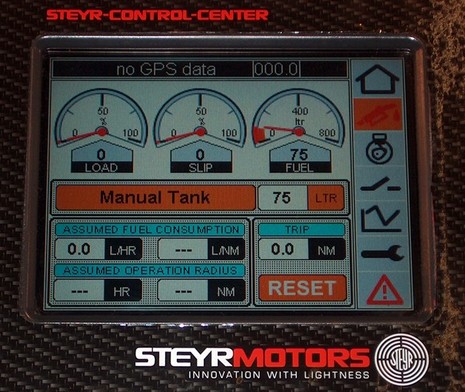
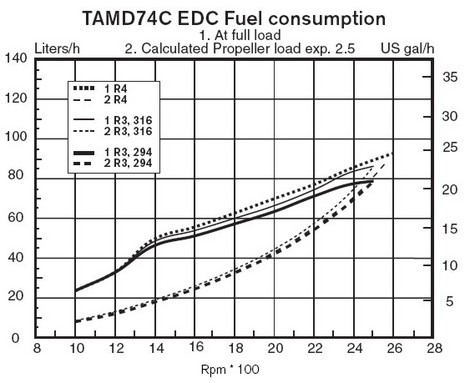
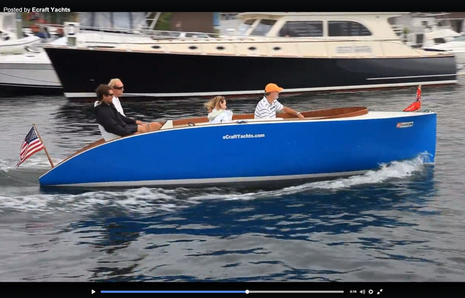
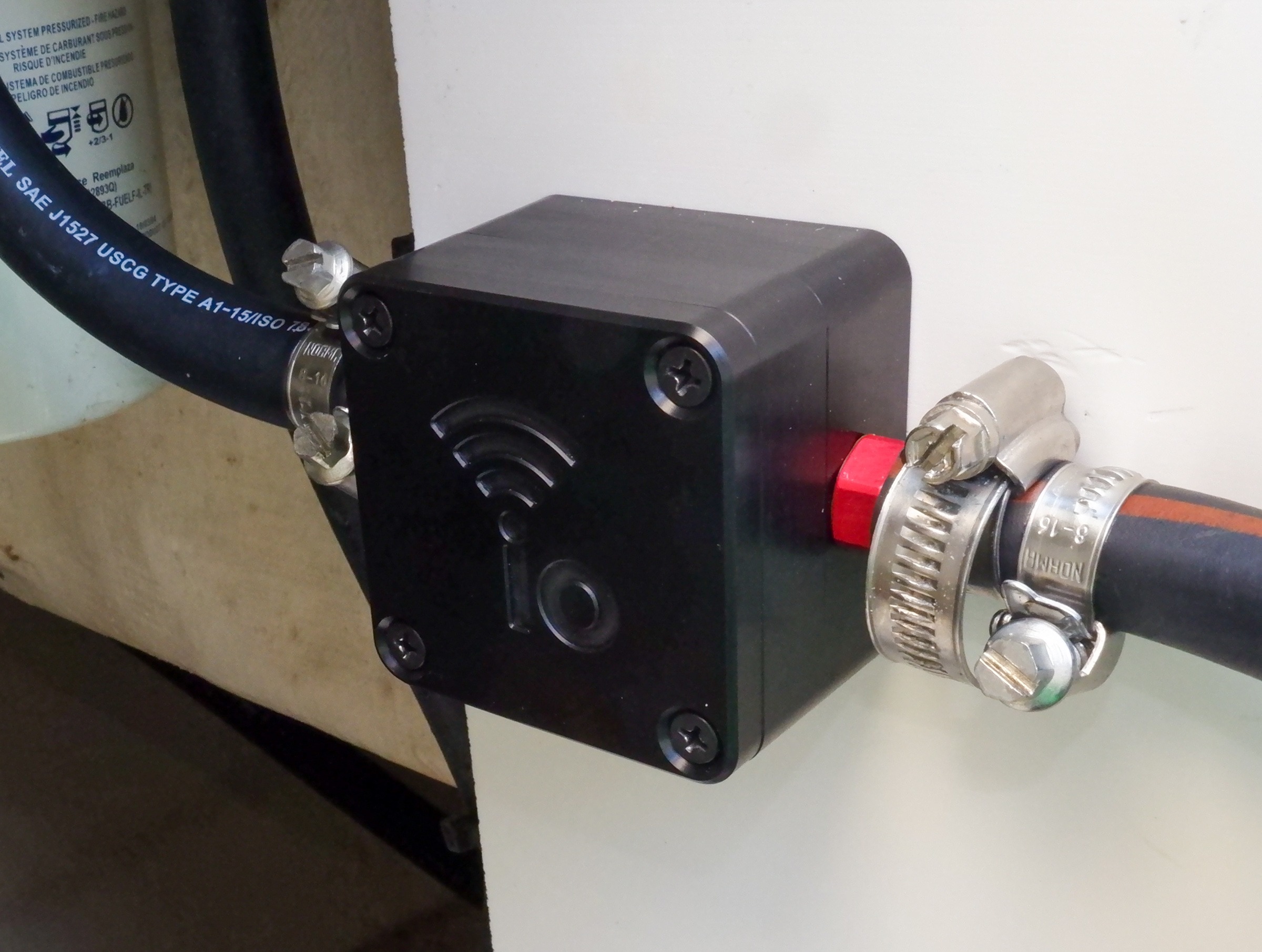
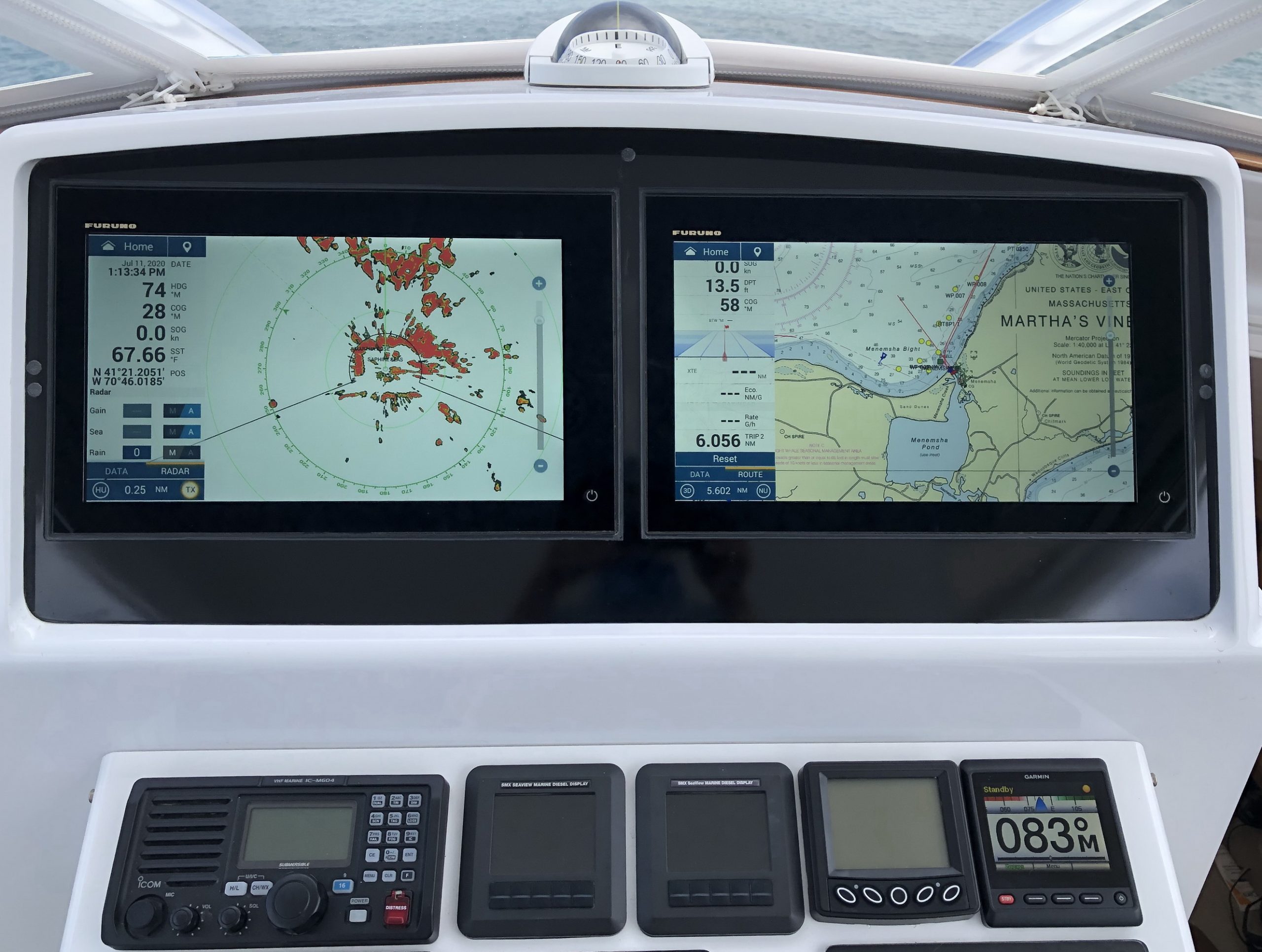








Is there a sweet spot, or just some speed ranges (for example just prior to planning) that are especially bad? Otherwise I would imagine the sweet spot is simply the point where ones patience to go faster or slower intersects with their tolerance to pay more for fuel?
I dub thee “Corcoran Equation”: the first truly accurate expression of the Man/machine relation. Eloquent.
Ben on my tug the Sally W the Flowscan system measures both incoming fuel to the engine and returning fuel to the tank and makes a calculation based on the difference. There are actually two fuel sensors in the system. I think that is fairly common. See you in Portland Sat?
Nah. I want to know more. For planing and semi-displacement power boats like Gizmo there are often several mpg vs rpm spots that are more efficient, and the spots move. Of course slower is more efficient, so which spot you pick at any given time is a mater of patience vs wallet.
In fact, I ran Gizmo at displacement speeds a lot last season, partly because I can’t yet tell how fast the meter’s running. But when it’s rougher, she’s often more comfortable shouldering along at higher speeds.
I cannot comment on the accuracy of diesel engine fuel flow, but I have an interesting observation on fuel mileage in general.
I have a gasoline engine powered, planing hull boat with an older Navman chart plotter and a fuel flow sensor. The plotter is set up to display economy in NM/Gal. As expected, the mileage is pretty good at very slow speeds, goes down considerable as the boat gets on plane, and it increases after that.
The boat gets better mileage at a fast cruise of 20-22 knots than it gets below that, even though it is comfortably on plane at lower speeds and engine RPM. In addition, the economy reading can be used to fine tune the boat using trim tabs and sterndrive angle. This will result in even better mileage.
The point is that a reading of fuel flow is not as useful as an economy reading. Even if a fuel flow sensor is not totally accurate in terms of actual fuel flow, an economy readout can be used to get the best mileage for the prevailing conditions.
I have Cat 3406E engines with Cat electronic gauges. The gauges show both load (as a percentage of 100%) and fuel burn. My understanding from my Cat mechanic is that fuel burn is not actually measured, but comes from a formula/table based on load, and that the only way to actually measure fuel burn is with sensors like Floscan which measure fuel flow in the return lines.
Ben,
I don’t know anything about electronically controlled diesel engine fuel systems. But, I’m reasonable knowledgeable when it comes to old systems which bypass fuel.
I assume that all bypassed fuel is returned to the tank with a single fuel return line? If so, why would it be difficult to install a second fuel flow sensor in the return line to determine how much fuel is bypassed? Fuel supplied minus fuel returned equals fuel consumed, no?
Butch
Let’s say Butch is right, and actual fuel consumed equals fuel injected minus fuel returned, and that you have a flow meter on the return. Are the existing N2K display systems (N2KView and gauges from Maretron, Garmin, Raymarine, etc.) capable of displaying this calculated value?
Ben have read your question again and think I know what you want to know but it will take some time on the water to plot the fuel usage against the boat speed and engine rpms. So I cannot satisfy you curiosity right now. What I can tell you is at 1800 rpms I am doing about 7 knots and burning 1.5 gal/hr. That is in the Lord Nelson tug.
Fuel consumption measurements on diesel engines are non trivial (and Floscans are so expensive) because one most compute the difference between the measurements on two sensors. While this is simple subtraction, any errors in either sensor are greatly magnified. The result is that your need very accurate and well very well calibrated sensors.
I don’t see why a modern diesel engine is any different from a petrol/gasoline. As far as I know, our diesel ECU calculates the duration and therefore amount of fuel bein injected through each injector and uses that to determine the amount of fuel being used. The excess fuel from the high pressure fuel rail being returned to the tank is irrelevant. Obviously as the injector ages and clogs up the amount actually injected will reduce, but I doubt that will be of major significace. My Suzuki outboard uses the same system for measuring fuel use. There is definitely no fuel flow sensor in teh fuel pipework under the cowl.
It depends… The fuel consumption figures from an electronically controlled high pressure common rail engine should be extremely precise — I have been told that it is a higher precision than you can obtain through a flo-scan. The reason for this is that diesels are trying to meet emissions targets which requires that you have almost exact control over how much fuel makes it into each cylinder. (Unburned fuel = soot = one component of emissions.) This is controlled by high precision selonoids, so fuel return from the fuel pump (if any) should not be an issue.
I have seen the Deere/Lugger diagnostic program in action and it is pretty amazing to see one of these engines hooked up to a diagnostic laptop — an enormous number of esoteric parameters are recorded and graphed. You would love it!
I don’t know the answer, but have pondered this for quite some time. Here are my thoughts:
1) It seems likely to me that the ECM/ECU can very accurately “measure” the amount of fuel going through each injector; since the fuel going through the injector goes into the chamber, none of it is returned to the fuel tank — no need to measure that.
2) If the ECM/ECU does have a means of determining load, then it could “look up” the corresponding fuel flow. But, I don’t see how it could determine load. (Strain guages are conceivable, but I doubt they are used on typicall.) Instead, it is my guess that it measures fuel flow and “looks up” the load — not the other way around. Similarly, if the ECU/ECM cannot measure load, then it can’t use load to look-up fuel consumption — it must be calculating fuel consumption.
Rick/Traveler
To the second part of your question — the published fuel consumption/speed charts are estimates using a particular prop pitch and transmission ratio, with a lot of standard assumptions about how efficient the prop and transmission are. (That is the calculated prop load, the other line is full load which is usually unobtainable on a boat because propellers are not efficient at the lower end of the RPM curve.)
What is known pretty precisely for electronic controlled engines is the fuel burn at a given RPM. How fast that RPM moves your boat under various conditions is what varies — and it can vary for apparently identical boats under the same conditions!
There is a bunch of complicated math involved for all of this guesswork, but the good news is that with an actual boat in your hands you can calculate what you really want to know easily. The easiest is to do a series of speed trials on a calm day, usually with a couple of trials in opposite directions to account for current. From that you can figure out how fast your boat goes in normal conditions for a given RPM, and from there you can get the MPG.
The very first thing you should do, by the way, is ensure that you reach the boat’s rated RPM at wide open throttle. You should test this every so often. If you go much over the maximum RPM with a loaded boat then call someone, if you don’t reach rated RPM then you probably need to clean the bottom.
This thread was cross-posted to a mailing list I follow, where it was answered by Northern Lights/Lugger’s Bob Senter, a noted diesel expert. He wrote:
“The short answer to your question is, if the engine is running normally, e.g., no unusual smoke, roughness or power complaints, the accuracy of the fuel burn and rate calculation is much better than you’d expect – virtually dead accurate. In order to meet US EPA Tier II or Tier III emission standards, the amount of fuel injected per firing cycle and timing accuracy are held to insanely tight standards. Fuel rate and burn is based on commanded fuel quantity X RPM (which also produces a % load number). Worst case scenario would be an injector or several injectors that are not supplying all the fuel
commanded. The result is that the indicated fuel consumption is greater than actual, so, the error is in your favor – you won’t burn more fuel than indicated but you might consume less.”
“2) If the ECM/ECU does have a means of determining load, then it could “look up” the corresponding fuel flow. But, I don’t see how it could determine load.”
The magic box determines load by tables from factory testing. Fuel is metered to maintain a given RPM. At that given RPM the engine is programmed to produce a given amount of work. If you set the throttle for 1800 RPM and the engine is lightly loaded, the box adjusts fuel delivery for 1800 RPM with room to spare for more load.
Put a bigger wheel on the boat and set the throttle for 1800 rpm and fuel delivery must go up to make that RPM against the new load. In mechanical injection systems it is easy to over fuel because there is no measurement and integration of engine running variables with predetermined limits and settings.
The electronic engine says wait, this guy is trying to run me beyond what the factory says is max fuel for 1800 rpm, i.e., above the load that the engine is capable of handling at 1800 RPM. When the tech plugs in the laptop for service he will look at you with a frown. Measuring fuel delivery against RPM tells them a lot about load.
I looked at the CAT diagram for their HEUI system (Hydraulically actuated electronically controlled unit injectors). There was no return fuel meter, it’s all in the computer. This system and the common rail system can adjust squirts from injector to injector, do double squirts or a small squirt for ignition and then a big squirt for power. The timing can be changed on the fly and by cylinder. All for economy and clean stack.
So the entire fuel system must be a precision device with very fast response run by a busy box. If you count the squirts and amount of every squirt over time you get fuel consumption. With fuel consumption and RPM and boost pressure and air temp etc. you can derive all sorts of stuff.
Don’t know how accurate this makes the info on fuel consumption that is displayed on the helm panel however. This might just be a moving average to provide a smooth reading. I never did track the total computed fuel burn versus the fill up gallons, several years of data could have been useful now. No matter what it was going to be an American Distress don’t leave home without it moment. -Doug
I have enjoyed the comments on modern electronically controlled diesel engines. There are obviously a lot of very sophisticated systems at work with a lot of data available. I would guess that there is far more data available than there is data that is useful to most boat owners or captains.
KISS is a great idea for operating and maintaining vessels. With that in mind when a diesel engine is installed which bypasses fuel for any reason during operation a very good and accurate enough for most operators fuel use system is a pair of flow sensors providing fuel supplied vs fuel returned. Not elegant nor pretty but very dependable and useful.
Two sensors will obviously capture consumption though I never can see makes floscans so expensive. I suspect it’s lack of competition.
ECU controlled diesels especially unit injector ones will have precise fuel consumption by default and this will be more accurate then flow and return sensors
I suspect that in styers case the engine is a rack controlled injector system so it is computing mpg from graphs
dave
Here is a bit of empirical data from the next generation Volvo EVC system used on their newer common rail D6 series engines. Over several thousand gallons of fuel burn, my total consumption reading off the EVC display for two engines combined is within 2% of the actual as measured by how much fuel goes into the tank. If the total consumption number is verifiably correct, it would seem logical that the current fuel burn rate numbers must also be of similar accuracy.
So I don’t know whether this is due to a very good algorithm or the system is actually able to use the data from the commands it gives to inject fuel, but it works. I should note that this is better accuracy than I experienced with a Floscan on my old Diesel boat using sensors in the supply and return lines. That had repeated accuracy of 3-5%.
I think that the modern Diesel is one of the unsung engineering marvels of this century. Back when the diesel emissions standards were first considered, Tier II was thought to be uneconomic and Tier III was thought to be technically impossible. You can buy Tier III engines today, and Tier IV engines are under development.
People have gotten so used to clean diesels that people call the fire department when one of the older smokey ones gets started!
Ben,
On some of my other forums this has come up as well. Its not a small amount of fuel being returned to the tank either potentially. Those with the John Deere 6081AFM engines see as much as 100 GPH of fuel returned to the tank at full power.
I would put a lot of faith into Bob Senter’s comments as well… That modern day ECU motors can count injections via the ECU and know exactly the correct fuel burn.
Thanks,
Chris
I super appreciate all the well informed comments here, but I still feel a dite uncertain about the fuel flow accuracy of electronic diesels. Could it be that some types are more accurate than others?
I have to say that I am impressed. There are an awful lot of people who, having made a mistake, would say nothing, hope no one noticed, or even try to deny it. Way to man-up, Ben!
Ben,
I think there is also a cultural component involved here. Steyr is Austrian, not American — and if I may over-generalize here for a moment the German-speaking countries are generally more precision (and precise language) oriented.
Just imagine the scene in the lab:
“Herr Schultze, please report, what does zis do?”
“Zis shows ze current fuel consumption, herr Diplom-Ingenieur.”
“And how does zis measure ze fuel flow then?”
“Vell it does not actually measure it, it reads a value from a consumption map, Zir.”
“You’d better call it ASSUMED fuel flow then.”
“Jawohl, herr Diplom-Ingenieur.”
Sorry to be reading this thread only now, but it sounds like you have your answers already. Most diesel engines return a rather large amount of unburned fuel, hopefully back to the tank it was drawn from.(In a multi-tank boat, that is an important consideration.)
Engine fuel burn information from OEM use formulas to reflect what the manufacturer has determined in its published graphs of fuel consumption. (It is the same for printer ink cartridges; your computer informs you that the printer’s color ink cartridge is almost empty when in fact it prints color just fine for some time longer.)
Most larger cruising powerboats and trawlers have FloScan instruments installed because they accurately show actual fuel burn at any particular rpm. This is very helpful for you to then construct a fuel/speed curve for your particular boat, with your props)and the general running condition of your boat. It will vary with varying tank levels, etc, but is still helpful. You can use this chart to determine the sweet spot of your boat, rather than try to figure it out from manufacturer’s published information for your engine(s).
FloScan is very helpful instrumentation for any cruising powerboat and will pay for itself in fuel consumption situational awareness.
With such instruments, you also have a diagnostic tool, where you know when something unusual is happening. Say,your fuel burn suddenly goes up for no apparent reason. That might be because your prop is fouled. Or in the case of one trawler I know, the bulbous bow picked up a fishing net in the Pacific and dragged it for days like a Fu Manchu mustache.
Glad your engine is back in the game!
Thanks, Bill, but I gotta say I’m still confused about this subject. I trust that FloScan gear works well, but it is added expense and plumbing. The big question remains: Do electronic engines which report fuel flow actually measure burned fuel (i.e. fuel flowing in minus fuel returned, like FloScan, or fuel actually squirted through the injectors) or do they just reference an internal table of typical rates for various rpms and loads (i.e. the equivalent of the printed graph)? Judging largely from the wide range of comments above, I suspect some do it one way, and some the other.
The BillP commenting above is Bill Parlatore, the founder of PassageMaker magazine, and I’m happy to say that he’s just done some excellent reporting on the ECM fuel question posed here. Grateful too! These are progress notes toward a complete PM article to come:
So far in my research, all of the engine companies seem to be performing essentially the same process of calculating fuel consumption. To begin with, I was reminded that the majority of marine engines out there today are from the automotive world, where millions of dollars have been invested in monitoring electronic fuel injection (MEFI) and its development. Additionally, companies such as Bosch and Nippon Denso supply ECMs (aka ECU) to engine manufacturers after exhaustive research and development programs. A couple of these gearheads were originally from this world, such as GM Powertrain and Ford.
None of the electronic engines have the ability to measure actual fuel flow.
As it was explained, no matter if it is a Cummins, Yanmar, Scania, BMW, Lugger, Deere, or other brand, when an engine undergoes its development, the engineers map the ECM by developing an algorithm that takes into account key factors, such as injector temperature and cylinder pressure, even fuel density.
Jennifer Barrett of John Deere best summed up the Holy Grail of this mapping program: How much fuel do we need in order to provide the necessary power for these conditions at this speed?
The ECM “commands” the injector (funny use of the word, but I heard it used in this context from several people) to be open for a precise amount of time to inject a specific number of milligrams of fuel per stroke to achieve the required power at the engine speed requested by the throttle.
All the folks I’ve connected with (so far, seven) were clear that during this development, the amount of fuel actually burned is definitely compared to the calculated fuel burn, and checked and rechecked to make sure that the resulting difference, if any, is very small. Some assumptions are made during the mapping, as some variables, such as internal tolerances and fuel type and temperature (which affect fuel density), might keep it from being 100 percent accurate. But really, really close.
And just how accurate does it need to be? Other than my wife, Laurene, does anyone really wait to buy gas when the car’s MFD says there are still 28 miles left in the tank?
Everyone agreed that the best test for accuracy, and to build confidence, is the use of a totalizer that totals the fuel used, a function offered by almost all engine companies (for whatever reason, Yanmar engines do not provide this function).
When the boat is running light at a specific rpm, the fuel burn shown at the helm will be less than when the boat is heavily loaded running at the same rpm. The power requirement is different and the ECM adjusts its commanding of the injectors accordingly. Tino Mastry used as an example his experience running his Mainship at 2500 rpm. Lightly loaded he burns 24 GPH. Fully loaded he burns 28 GPH at the same rpm. And he has gained such confidence in this engine information that he now uses fuel burn to synchronize his engines rather than rpm.
Everyone commented on the value of the totalizer. Run a boat and consume an amount of fuel, say 200 gallons as per the helm display. Then go fill your tanks, and see how close it is. It should be really close, given the somewhat vague process of refueling a boat, which is not quite as black and white as filling the tank on a lawnmower.
I will wait to hear from a couple of others, but I think this answers your question. Mastry’s Ron List suggested that if one’s engine does not offer the totalizer function, some plotters and other electronics can perform this function if connected to the ECM output. He mentioned Raymarine, Lowrance, and Murphy, but wasn’t completely sure. But that is your area of expertise, Ben, and perhaps you know more about that.